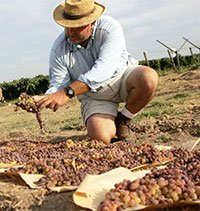School crop unhurt

Joseph Vasquez /
The Collegian
If these grapes remain
wet for too long they will mold, which is why vintner John Tufenkjian
lays them out to dry after Tuesday’s storms. |
By Bardley Hart
The Collegian
Fresno State officials are breathing
a sigh of relief after evaluating damage from recent rain that could have
damaged crops.
Thunderstorms rolled into the Central Valley Tuesday night, dropping rain
that had the potential to cause big problems for some growers.
“We don’t have any significant damage,” said Ganesan
Srinivasan, director of the Agriculture Field Lab. “We just delayed
harvesting some of the produce but there is practically no damage.”
While Fresno State’s crops seemed to escape serious harm, other
Valley farmers may not be as fortunate.
“The weather is absolutely critical at this time of year for certain
types of crops,” said Liz Hudson, Fresno County Farm Bureau outreach
coordinator. “Any amount of measurable precipitation can cause problems
with the harvest.”
Among the crops that could have been affected by the storm are those approaching
harvest and production time, including grapes, raisins and tomatoes, Hudson
said. Fresno State’s field labs grow several varieties of grapes
for direct consumption and use in wine.
This year’s raisin harvest has already been blighted by a series
of problems, including labor difficulties.
The storm hit at a particularly precarious time for producers as some
of their crop has already been picked and placed on the ground for drying.
According to Farm Bureau statistics, Fresno County is the nation’s
top producer of raisins, accounting for 85 percent of the country’s
supply.
Any loss of crop could have an unknown impact on future prices, Hudson
said.
One potential bright spot for growers is that weather late in the week
was mostly sunny and warm, which could prevent mold from growing by drying
out grapes that are already on the ground.
“You want to avoid moisture on your fruit at this time of year,”
Hudson said. “It can cause rotting or it can affect the skin.”
Fresno State’s crops may be prone to disease in the future, but
officials are taking steps to prevent problems, Srinivasan said.
Fresno County Department of Agriculture officials said they are unable
to comment on possible crop damage until early next week when a county-wide
assessment will be completed.
According to experts, there is no reliable way to protect most crops from
weather damage that can sometimes lead to catastrophic losses, as was
the case with last year’s crop of Florida oranges.
Citrus prices were driven up steeply when portions of the state were devastated
by a series of four hurricanes.
In 2000, about 10 percent of California’s raisins were destroyed
in an early rainstorm, according to government figures. However, the overall
size of the harvest was more than enough to make up for the loss and prices
saw an overall decline because of a series of market factors.
Raisin growers face a particular dilemma deciding when to pick their grapes
and set them out for drying.
The longer a grape stays on the vine the sweeter it becomes but if a grower
waits too late in the year they run the risk of losing their crop to the
weather.
Comment
on this story in the News forum >>
|
